FTD Respiratory pathogens 21 - Mikrogen
FTD Respiratory pathogens 21 - Mikrogen
FTD Respiratory pathogens 21 - Mikrogen
Create successful ePaper yourself
Turn your PDF publications into a flip-book with our unique Google optimized e-Paper software.
Manual<br />
24 (catalog no. <strong>FTD</strong> 2-24/4)<br />
48 (catalog no. <strong>FTD</strong> 2-48/6)<br />
96 (catalog no. <strong>FTD</strong> 2-96/12)<br />
Qualitative assay for in vitro diagnostics<br />
<strong>FTD</strong> <strong>Respiratory</strong> <strong>pathogens</strong> <strong>21</strong> version 3/ March 2012 english<br />
<strong>FTD</strong> <strong>Respiratory</strong> <strong>pathogens</strong> <strong>21</strong><br />
For use with the<br />
ABI 7500, Bio-Rad CFX96, LightCycler ® 480,<br />
RotorGene 6000/ Rotor-Gene Q<br />
<strong>FTD</strong> 2-24/4; <strong>FTD</strong> 2-48/6; <strong>FTD</strong> 2-96/12<br />
Fast-track Diagnostics; 38, rue Hiehl; L-6131 Junglinster; Luxembourg<br />
- 1 -
Table of Contents<br />
<strong>FTD</strong> <strong>Respiratory</strong> <strong>pathogens</strong> <strong>21</strong> version 3/ March 2012 english<br />
<strong>FTD</strong> <strong>Respiratory</strong> <strong>pathogens</strong> <strong>21</strong><br />
1. IDENTIFICATION OF THE MANUFACTURER ............................................... 3<br />
2. IDENTIFICATION OF THE PRODUCT .......................................................... 3<br />
3. INTENDED USE ........................................................................................... 3<br />
4. PATHOGEN INFORMATION ........................................................................ 4<br />
5. CONTENTS .................................................................................................. 6<br />
6. PRECAUTIONS AND WARNINGS ................................................................ 7<br />
6.1 SAFETY INFORMATIONS ................................................................................ 7<br />
6.2 HANDLING REQUIREMENTS ............................................................................ 7<br />
6.3 SAFE WASTE DISPOSAL ................................................................................. 7<br />
7. STORAGE AND STABILITY CONDITIONS .................................................... 7<br />
8. PRINCIPLE OF THE METHOD ...................................................................... 8<br />
9. ADDITIONALLY REQUIRED EQUIPMENT .................................................... 8<br />
10. SAMPLES .................................................................................................... 9<br />
11. PROCEDURE ............................................................................................... 9<br />
11.1 PRELIMINARY PROCEDURE WITH USING THE EASYMAG ....................................... 9<br />
11.2 MAIN PCR SETUP PROCEDURE WITH USING THE AGPATH ONE-STEP RT-PCR KIT ... 10<br />
12. PROGRAMMING OF THE THERMO CYCLER ............................................... 14<br />
13. ASSAY VALIDATION ................................................................................. 15<br />
14. CALCULATION OF THE RESULTS ON THE ABI 7500 .................................. 16<br />
15. INTERPRETATION OF RESULTS ................................................................ 18<br />
16. TROUBLESHOOTING ................................................................................ 20<br />
17. VALIDATION ............................................................................................ <strong>21</strong><br />
17.1. SPECIFICITY .................................................................................... <strong>21</strong><br />
17.2. SENSITIVITY .................................................................................... 22<br />
17.3. CLINICAL EVALUATION ........................................................................ 24<br />
18. LEGEND OF SYMBOLS ............................................................................... 26<br />
- 2 -
1. Identification of the manufacturer<br />
Fast-track Diagnostics Luxembourg S.à.r.l.<br />
38, rue Hiehl<br />
Z. I. Laangwiss<br />
L-6131 Junglinster<br />
Tel. +352 780290 329<br />
Fax: +352 780290 514<br />
info@fast-trackdiagnostics.com<br />
2. Identification of the product<br />
<strong>FTD</strong> <strong>Respiratory</strong> <strong>pathogens</strong> <strong>21</strong> version 3/ March 2012 english<br />
<strong>FTD</strong> <strong>Respiratory</strong> <strong>pathogens</strong> <strong>21</strong><br />
<strong>FTD</strong> <strong>Respiratory</strong> <strong>pathogens</strong> <strong>21</strong><br />
Category: Multiplex PCR for detection of respiratory <strong>pathogens</strong> –<br />
including internal control<br />
Reference: <strong>FTD</strong> 2-24/4 Test for 24 patients, 6 assays, each for 4 specimens<br />
<strong>FTD</strong> 2-48/6 Test for 48 patients, 8 assays, each for 6 specimens<br />
<strong>FTD</strong> 2-96/12 Test for 96 patients, 8 assays, each for 12 specimens<br />
Indication: For in vitro diagnostics.<br />
3. Intended use<br />
The <strong>FTD</strong> <strong>Respiratory</strong> <strong>pathogens</strong> <strong>21</strong> (<strong>FTD</strong> Resp <strong>21</strong>) is an in vitro test with five<br />
multiplex RT-PCR reactions for the detection of: influenza A (FluA), A(H1N1)swl<br />
(H1N1), B (FluB); coronaviruses NL63 (Cor63), 229E (Cor229), OC43 (Cor43) and<br />
HKU1 (HKU), parainfluenza 1, 2, 3 and 4 (Para1, Para2, Para3, Para4), human<br />
metapneumovirus A and B (HMPVA and B), rhinovirus (Rhino), respiratory<br />
syncytial viruses A and B (RSVA and B), adenovirus (AV), enterovirus (EV),<br />
parechovirus (PV), bocavirus (HboV), Mycoplasma pneumoniae (Mpneu) as an<br />
aid in the evaluation of infections by respiratory <strong>pathogens</strong>.<br />
- 3 -
4. Pathogen information<br />
<strong>FTD</strong> <strong>Respiratory</strong> <strong>pathogens</strong> <strong>21</strong> version 3/ March 2012 english<br />
<strong>FTD</strong> <strong>Respiratory</strong> <strong>pathogens</strong> <strong>21</strong><br />
FluA and FluB are important viral infections of the respiratory tract of adults and<br />
children. Most cases occur during the annual winter epidemics. Severe infections<br />
can occur in the immunocompromised, those with chronic cardiac, pulmonary or<br />
metabolic disease and in the extremes of age. Most symptoms include fever,<br />
myalgia, sore throat and cough. In children gastrointestinal symptoms can also<br />
be present. Complications of influenza infection include primary (viral) or<br />
secondary (bacterial) pneumonia, cardiac involvement and neurological illness<br />
(including encephalopathy, encephalitis and Reyes syndrome. The swine-lineage<br />
influenza A virus subtype H1N1 (=A(H1N1)swl) was reported in spring<br />
2009.<br />
Para1, 2, 3, and 4 are common causes of upper and lower respiratory tract<br />
infections. Types 1 and 2 tend to occur mostly in the winter months whereas<br />
type 3 occurs mainly in the spring. Type 1 and 2 are commonly associated with<br />
croup in young children. Type 3 is second only to RSV as a cause of bronchiolitis<br />
and pneumonia in infants. Please note that these <strong>pathogens</strong> can also cause<br />
severe infections in immunocompromised patients, especially type 3.<br />
Rhino cause about one half of colds. There are over 100 types of rhinovirus<br />
known to cause respiratory infection in humans. They are common in all age<br />
groups and can cause upper and lower respiratory tract infections. They are a<br />
significant cause of bronchiolitis. Increased testing has implicated these viruses<br />
in severe infections, asthma and COPD. Severe infections are also likely to occur<br />
in immunocompromised.<br />
Cor229, Cor63, Cor43 and HKU are frequent causes of the common cold<br />
(second only to rhinoviruses). There have also been reports of pneumonia in the<br />
elderly, infants and immunocompromised. Increased testing will probably lead to<br />
detection of coronaviruses in severe upper and lower respiratory tract infections<br />
in other patient groups.<br />
RSVA and RSVB are common causes of respiratory illness in all age groups.<br />
Most infections tend to occur during the winter season (December-March in the<br />
Northern hemisphere). RSV is of particular importance as a cause of severe lower<br />
respiratory tract infection in infants (causing bronchiolitis and pneumonia),<br />
immunocompromised (especially BMT patients) and the elderly.<br />
- 4 -
<strong>FTD</strong> <strong>Respiratory</strong> <strong>pathogens</strong> <strong>21</strong> version 3/ March 2012 english<br />
<strong>FTD</strong> <strong>Respiratory</strong> <strong>pathogens</strong> <strong>21</strong><br />
HMPV causes a spectrum of respiratory illness, ranging from mild upper<br />
respiratory tract infections to severe bronchiolitis and pneumonia. HMPV is<br />
associated with a rate of community acquired respiratory illness similar to that of<br />
the parainfluenza viruses and influenza virus but substantially less than that<br />
associated with RSV. HMPV may be responsible for a significant portion of the<br />
>150000 bronchiolitis hospitalizations in infants and children younger than 5<br />
years. HMPV has been recently identified in children and adults with acute<br />
respiratory tract infections (ARTI) in various parts of the world.<br />
AV are a common cause of respiratory infection (ranging from pharyngitis to<br />
severe pneumonia), eye infections (conjunctivitis and kerato-conjunctivitis) and<br />
gastrointestinal illness. Adenoviral infections affect infants and young children<br />
much more frequently than adults. Severe, disseminated infection can occur in<br />
immunocompromised. Rarely, adenoviruses can be a cause of haemorrhagic<br />
cystitis which mostly occurs in immunocompromised but has also been found in<br />
immunocompetent.<br />
HboV is a parvovirus that is one of the most common viruses in respiratory<br />
samples. The age group most frequently affected appears to be children between<br />
the ages of six months and two years. Symptoms of respiratory tract infection,<br />
gastrointestinal symptoms and skin rash were reported. It is one of only 2 known<br />
human parvovirus <strong>pathogens</strong>; the other is parvovirus B19. In general,<br />
parvoviruses are more important as veterinary <strong>pathogens</strong>.<br />
EV are implicated in a number of different clinical illnesses. EV are associated<br />
with a febrile illness sometimes with a rubelliform rash. They also cause aseptic<br />
meningitis. Other disease associations include herpangina (vesicles in the throat),<br />
hand foot and mouth disease, Bornholm disease (painful chest pain) and<br />
myocarditis. Enterovirus infection in neonates can be severe. Some enterovirus<br />
types are associated with acute haemorrhagic conjunctivitis. EV are unusual in<br />
winter.<br />
PV have as the other picornaviruses a single-stranded RNA genome of positive<br />
polarity. 60% of PV infections occurred in children under 1 year of age.<br />
The major peaks are during late summer and autumn, resembling the epidemic<br />
pattern of enteroviruses, and less frequently, during the winter and early spring.<br />
Diarrhea is the most common clinical manifestation, followed by respiratory<br />
symptoms. Although CNS manifestations are rather rare in this patient group, an<br />
association of PV infections with encephalitis and flaccid paralysis has also been<br />
described.<br />
- 5 -
<strong>FTD</strong> <strong>Respiratory</strong> <strong>pathogens</strong> <strong>21</strong> version 3/ March 2012 english<br />
<strong>FTD</strong> <strong>Respiratory</strong> <strong>pathogens</strong> <strong>21</strong><br />
Mpneu is a small bacterium in the class Mollicutes. Mpneu is a common cause of<br />
upper respiratory tract infections with fever, cough, malaise, and headache. It<br />
may lead to tracheobronchitis with fever and nonproductive cough: radiologically<br />
confirmed pneumonia develops in 5-10 % of cases; rare extrapulmonary<br />
syndromes, including cardiologic, neurologic, and dermatologic findings. The<br />
transmission is by person-to-person contact with respiratory secretions.<br />
Incubation period is 1 to 4 weeks.<br />
5. Contents<br />
Table 1: PP = primer and probe, IC = internal control, PC = positive control, NC = negative<br />
control<br />
Label Contents<br />
<strong>FTD</strong><br />
2-24/4<br />
<strong>FTD</strong><br />
2-48/6<br />
<strong>FTD</strong><br />
2-96/12<br />
FluRhino Primer/probe mix for Influenza 6 x 11 µl 8 x 14 µl 8 x 24 µl<br />
PP A, B, H1N1 & Rhino<br />
Cor Primer/probe mix for Cor63, 6 x 11 µl 8 x 14 µl 8 x 24 µl<br />
PP Cor43, Cor229 & HKU<br />
Para.EAV Primer/probe mix for Para2, 3, 6 x 11 µl 8 x 14 µl 8 x 24 µl<br />
PP 4 & IC<br />
BoMpPf1 Primer/probe mix for Para1, 6 x 11 µl 8 x 14 µl 8 x 24 µl<br />
PP HMPV A & B, HboV & Mpneu<br />
RsEPA Primer/probe mix for RSVA & B, 6 x 11 µl 8 x 14 µl 8 x 24 µl<br />
PP AV, EV & PV<br />
Positive control: plasmid pool 6 x 55 µl 8 x 55 µl 8 x 55 µl<br />
Resp<br />
PC<br />
for FluA, FluB, H1N1swl, Rhino,<br />
Cor63, Cor229, Cor43, HKU,<br />
Para1, 2, 3, 4, HMPV, HboV,<br />
Mpneu , RSV, Adeno, EV & PV<br />
Resp<br />
NC<br />
Negative control 6 x 220 µl 8 x 220 µl 8 x 220 µl<br />
Resp<br />
IC<br />
Internal control<br />
6 x 11 µl 8 x 16 µl 8 x 29 µl<br />
The box itself, the cover of the box and each vial are labelled with a lot number.<br />
- 6 -
6. Precautions and warnings<br />
6.1 Safety informations<br />
<strong>FTD</strong> <strong>Respiratory</strong> <strong>pathogens</strong> <strong>21</strong> version 3/ March 2012 english<br />
<strong>FTD</strong> <strong>Respiratory</strong> <strong>pathogens</strong> <strong>21</strong><br />
Warning notice: the negative control contains lysis buffer.<br />
Hazard description: Xn Harmful<br />
Risk phrases:<br />
R 22 Harmful if swallowed.<br />
R 36/38 Irritating to eyes and skin.<br />
Safety phrases:<br />
S 13 Keep away from food, drink and animal feeding stuffs.<br />
S 26 In case of contact with eyes rinse immediately with plenty of water<br />
and seek medical advice.<br />
S 36 Wear suitable protective clothing.<br />
S 46 If swallowed seek medical advice immediately and show this<br />
container or label.<br />
6.2 Handling requirements<br />
Use of this product should be limited to personnel trained in the techniques of<br />
PCR. This product should be used in accordance with Good Laboratory Practice.<br />
Take the normal precautions required for handling all laboratory reagents.<br />
Do not mix reagents from different lots.<br />
Do not use the product after its expiration date (durability 1 year).<br />
6.3 Safe waste disposal<br />
Dispose of unused reagents and waste in accordance with country, state or local<br />
regulations.<br />
7. Storage and stability conditions<br />
This product should be stored in its original packaging at –20°C until the<br />
expiration date printed on the label. The product is shipped below 10°C. For<br />
stability performance data, please contact <strong>FTD</strong>. Freeze immediately after one<br />
column of reagents has been taken out. Each column of reagents within a kit is<br />
suitable for one test run of 4, 6 or 12 patients. Do not refreeze columns that<br />
have been taken out of the kit and thawed.<br />
- 7 -
8. Principle of the method<br />
<strong>FTD</strong> <strong>Respiratory</strong> <strong>pathogens</strong> <strong>21</strong> version 3/ March 2012 english<br />
<strong>FTD</strong> <strong>Respiratory</strong> <strong>pathogens</strong> <strong>21</strong><br />
RNA is transcribed into cDNA using a specific primer mediated reverse<br />
transcription step followed immediately in the same tube by polymerase chain<br />
reaction. Detection of products is via a dual labelled molecular probe for each<br />
virus and bacteria of the multiplex PCR. The presence of specific viral and<br />
bacterial sequences in the reaction is detected by an increase in the fluorescence<br />
observed from the relevant dual-labelled probe, and is reported as a cycle<br />
threshold value (Ct) by the real time thermo cycler.<br />
The assay uses Equine arteritis virus (EAV) as an internal control (IC), which is<br />
introduced into the lysis buffer at the extraction stage of each sample and the<br />
negative control. The internal control has to be extracted.<br />
9. Additionally required equipment<br />
The <strong>FTD</strong> Resp <strong>21</strong> is suited for use with the ABI 7500 (Applied Biosystems ® ), Bio-<br />
Rad CFX96 (BIO-RAD), LightCycler ® 480 (Roche) and RotorGene 6000 (Qiagen<br />
former Life Science Corbett)/ Rotor-Gene Q (Qiagen). The assay has been fully<br />
validated on an ABI 7500 with the AgPath-ID One-Step RT-PCR Kit (Ambion ® )<br />
and with the EasyMAG (bioMérieux). If you want to use different cyclers,<br />
enzymes or extraction methods, please firstly check their compatibility with <strong>FTD</strong>.<br />
• Real time PCR master mix and enzyme. We recommend the AgPath-ID<br />
One-Step RT-PCR Kit (Ambion ® , cat# 4387391).<br />
• Disposable powder-free gloves<br />
• Pipettes (adjustable)<br />
• Sterile pipette tips with filters<br />
• Vortex mixer<br />
• Desktop centrifuge<br />
• For the ABI 7500, Bio-Rad CFX96 and LightCycler ® 480 96 well PCR plates<br />
and plate sealers are recommended. For the usage of the RotorGene<br />
6000/ Rotor-Gene Q it is recommended to use 0.1 ml strip tubes and<br />
caps.<br />
• Sample rack<br />
- 8 -
10. Samples<br />
<strong>FTD</strong> <strong>Respiratory</strong> <strong>pathogens</strong> <strong>21</strong> version 3/ March 2012 english<br />
<strong>FTD</strong> <strong>Respiratory</strong> <strong>pathogens</strong> <strong>21</strong><br />
This test is for use with extracted RNA and DNA from respiratory samples<br />
(throat/nasal swabs, bronchoalveolare lavage and sputum) of human origin. In<br />
some cases other sample types may be tested including post mortem material<br />
such as heart and lung.<br />
For long term storage <strong>FTD</strong> recommends to store all samples at -20°C until<br />
extraction.<br />
11. Procedure<br />
11.1 Preliminary procedure with using the EasyMAG<br />
If you want to use different extraction methods, please firstly check their<br />
compatibility with <strong>FTD</strong>!<br />
Extraction of specimens and negative control with the EasyMAG:<br />
1. Thaw one negative control (Resp NC, 220 µl aliquot, white cap) and one<br />
internal control (Resp IC, blue cap).<br />
Before use, the reagents have to be thawed completely, mixed (by<br />
pipetting or short vortexing) and spun down briefly!<br />
2. Extract 4, 6 or 12 samples or multiples of 4, 6, 12 samples and the NC.<br />
We recommend a starting volume for the extraction of 200 µl and an<br />
elution volume of 55 µl.<br />
To increase the sensitivity of the test, you can use a higher starting<br />
volume for the extraction of your specimens according to your extraction<br />
method i.e. a starting volume of 400 µl and an elution volume of 55 µl.<br />
3. Add 2 µl internal control (IC, blue cap) directly to the lysis buffer of each<br />
extraction.<br />
Adding the internal control to each of your samples and to the negative<br />
control is a very important step to review the nucleic acid isolation has<br />
been successful and to check for possible PCR inhibition!<br />
4. Do not extract positive controls!<br />
- 9 -
<strong>FTD</strong> <strong>Respiratory</strong> <strong>pathogens</strong> <strong>21</strong> version 3/ March 2012 english<br />
<strong>FTD</strong> <strong>Respiratory</strong> <strong>pathogens</strong> <strong>21</strong><br />
11.2 Main PCR setup Procedure with using the AgPath One-Step RT-<br />
PCR Kit<br />
If you want to use a different enzyme to the AgPath-ID One-Step RT-PCR Kit<br />
please firstly check with <strong>FTD</strong>!<br />
Preparation of PCR with AgPath-ID One-Step RT-PCR Kit:<br />
1. Thaw reagents for the reaction: FluRhino PPmix, Cor PPmix, Para.EAV<br />
PPmix, BoMpPf1 PPmix and RsEPA PPmix, the positive control (Resp PC)<br />
and the 2xRT PCR buffer of AgPath-ID One-Step RT-PCR Kit. The PC`s<br />
and the extracted NC have to be included in each run.<br />
Make sure to keep the enzyme of the AgPath-ID One-Step RT-PCR Kit<br />
cool. It should be kept in a freezer or on a cooling block at all times!<br />
2. Reagents in each column are sufficient for:<br />
<strong>FTD</strong>-2-24/4 4 patients, including controls<br />
<strong>FTD</strong>-2-48/6 6 patients, including controls<br />
<strong>FTD</strong>-2-96/12 12 patients, including controls<br />
3. Pipette the required amount (see table 2 below) of the “2xRT PCR buffer”<br />
(AgPath-ID One-Step RT-PCR Kit) to the FluRhino PPmix, Cor PPmix,<br />
Para.EAV PPmix, BoMpPf1 PPmix and RsEPA PPmix.<br />
Take care to change the tips after each pipetting step.<br />
4. Pipette the required amount (see table 2 below) of the “25x RT-PCR<br />
enzyme mix” (AgPath-ID One-Step RT-PCR Kit) to FluRhino PPmix, Cor<br />
PPmix, Para.EAV PPmix, BoMpPf1 PPmix and RsEPA PPmix with the “2xRT<br />
PCR buffer”. Take care to change the tips after each pipetting step. Vortex<br />
the complete master mixes briefly and spin down in a centrifuge.<br />
- 10 -
<strong>FTD</strong> <strong>Respiratory</strong> <strong>pathogens</strong> <strong>21</strong> version 3/ March 2012 english<br />
<strong>FTD</strong> <strong>Respiratory</strong> <strong>pathogens</strong> <strong>21</strong><br />
Table 2: Shown are the amounts of reagents that are needed for one well and for multiples<br />
accordant to the kit size.<br />
<strong>FTD</strong>-2-24/4: The PPmix contained in one tube is sufficient for 7 reactions and includes 4<br />
patients, 1 NC, 1 PC, 10 % pipetting inaccuracy.<br />
<strong>FTD</strong>-2-48/6: The PPmix contained in one tube is sufficient for 9 reactions and includes 6<br />
patients, 1 NC, 1 PC, 10 % pipetting inaccuracy.<br />
<strong>FTD</strong>-2-96/12: The PPmix contained in one tube is sufficient for 15.5 reactions and includes 12<br />
patients, 1 NC, 1 PC, 10 % pipetting inaccuracy.<br />
<strong>FTD</strong>-2<br />
24/4<br />
<strong>FTD</strong>-2<br />
48/6<br />
<strong>FTD</strong>-2<br />
96/12<br />
Number of samples 1 7<br />
Preparation of the<br />
PCR assay<br />
- 11 -<br />
PP mix 1.5 µl 10.5 µl<br />
Enzyme 1 µl 7 µl<br />
Buffer 12.5 µl 87.5 µl<br />
Total 15 µl 105 µl<br />
Number of samples 1 9<br />
Preparation of the<br />
PCR assay<br />
PP mix 1.5 µl 13.5 µl<br />
Enzyme 1 µl 9 µl<br />
Buffer 12.5 µl 112.5 µl<br />
Total 15 µl 135 µl<br />
Number of samples 1 15.5<br />
Preparation of the<br />
PCR assay<br />
PP mix 1.5 µl 23.3 µl<br />
Enzyme 1 µl 15.5 µl<br />
Buffer 12.5 µl 194 µl<br />
Total 15 µl 232.8 µl
Preparation of a 96 well plate for the ABI 7500:<br />
<strong>FTD</strong> <strong>Respiratory</strong> <strong>pathogens</strong> <strong>21</strong> version 3/ March 2012 english<br />
<strong>FTD</strong> <strong>Respiratory</strong> <strong>pathogens</strong> <strong>21</strong><br />
All our tests are validated on the ABI 7500, so you need to take care when using<br />
different cyclers. If you want to use the Bio-Rad CFX96 or the LightCycler ® 480<br />
you must use appropriate plates and adhesive films. For the RotorGene please<br />
use adequate tubes for the correlating rotor. If you intend to run our tests on a<br />
different cycler to those mentioned please firstly check with <strong>FTD</strong>!<br />
Preparation of a 96 well plate for ABI 7500<br />
1. Take a 96 well plate which is compatible with the ABI 7500.<br />
2. Pipette 15 µl of the FluRhino PPmix with the “2xRT PCR buffer” and the “25x RT-<br />
PCR enzyme mix” in the wells.<br />
3. Pipette 15 µl of the Cor PPmix with the “2xRT PCR buffer” and the “25x RT-PCR<br />
enzyme mix” in the wells.<br />
4. Pipette 15 µl of the Para.EAV PPmix with the “2xRT PCR buffer” and the “25x RT-<br />
PCR enzyme mix” in the wells.<br />
5. Pipette 15 µl of the BoMpPf1 PPmix with the “2xRT PCR buffer” and the “25x RT-<br />
PCR enzyme mix” in the wells.<br />
6. Pipette 15 µl of the RsEPA PPmix with the “2xRT PCR buffer” and the “25x RT-PCR<br />
enzyme mix” in the wells.<br />
7. Add 10 µl of the extracted samples, the extracted negative control and the positive<br />
control (which is not extracted).<br />
Each run must include a negative and the positive control!<br />
8. Mix briefly by pipetting up and down.<br />
9. Close the plate with the ABI optical adhesive film.<br />
10. Centrifuge briefly.<br />
11. Put the plate in the ABI 7500.<br />
12. Figure 1 shows an example for location of samples and controls on an ABI 7500<br />
plate.<br />
- 12 -
<strong>FTD</strong> <strong>Respiratory</strong> <strong>pathogens</strong> <strong>21</strong> version 3/ March 2012 english<br />
<strong>FTD</strong> <strong>Respiratory</strong> <strong>pathogens</strong> <strong>21</strong><br />
Figure 1: Schematic presentation of an example for location of samples and controls<br />
on a 96 well plate for the ABI 7500.<br />
Rows A-H; columns 1-12 = layout of the 96 well plate<br />
S1; S2; S3; S4 = Master mix and samples 1-4<br />
Resp PC = Master mix and positive controls: rows A-E<br />
Resp NC = Master mix and negative control<br />
yellow background (row A) = Master mix with FluRhino PPmix<br />
red background (row B) = Master mix with Cor PPmix<br />
blue background (row C) = Master mix with Para.EAV PPmix<br />
purple background (row D) = Master mix with BoMpPf1 PPmix<br />
green background (row E) = Master mix with RsEPA PPmix<br />
- 13 -
12. Programming of the thermo cycler<br />
Pay particular attention to the settings for the detectors:<br />
<strong>FTD</strong> <strong>Respiratory</strong> <strong>pathogens</strong> <strong>21</strong> version 3/ March 2012 english<br />
<strong>FTD</strong> <strong>Respiratory</strong> <strong>pathogens</strong> <strong>21</strong><br />
Table 3: Settings for the detectors.<br />
FluA FAM green<br />
Detection wave<br />
length (nm) *<br />
~ 520<br />
Rhino VIC yellow ~ 550<br />
FluB ROX orange ~ 610<br />
H1N1 Cy5 red ~ 670<br />
Cor 229 FAM green ~ 520<br />
Cor 63 VIC yellow ~ 550<br />
HKU ROX orange ~ 670<br />
Cor 43 Cy5 red ~ 610<br />
Para3 FAM green ~ 520<br />
Para2 VIC yellow ~ 550<br />
Para4 ROX orange ~ 670<br />
IC (EAV) Cy5 red ~ 610<br />
Para1 FAM green ~ 520<br />
HMPV A/B VIC yellow ~ 550<br />
HboV ROX orange ~ 670<br />
Mpneu Cy5 red ~ 610<br />
RSVA/B FAM green ~ 520<br />
PV VIC yellow ~ 550<br />
EV ROX orange ~ 670<br />
AV Cy5 red ~ 610<br />
PP mix Pathogen Reporter Dye<br />
FluRhino<br />
PP<br />
Cor<br />
PP<br />
Para.EAV<br />
PP<br />
BoMpPf1<br />
PP<br />
RsEPA<br />
PP<br />
* The mentioned detection wave lengths are from the ABI 7500. They can be<br />
slightly different on other machines.<br />
PCR programme:<br />
50°C for 15 minutes hold<br />
95°C for 10 minutes hold<br />
40 cycles of: 95°C, 8 sec.<br />
60°C, 34 sec.<br />
- 14 -
<strong>FTD</strong> <strong>Respiratory</strong> <strong>pathogens</strong> <strong>21</strong> version 3/ March 2012 english<br />
<strong>FTD</strong> <strong>Respiratory</strong> <strong>pathogens</strong> <strong>21</strong><br />
The PCR programme might differ if using another enzyme than recommended.<br />
Detailed information on programming of the thermo cyclers is provided in the<br />
instruction manuals of the cyclers.<br />
NOTE:<br />
If you use the ABI 7500, it is necessary to change the setting for the passive<br />
reference dye. (By default, the ROX dye is selected). After the step specifying the<br />
detectors and task for each well, click finish and the software will create the<br />
plate document. Click on a well, or click-drag, to select replicate wells. Enter the<br />
sample name and change the passive reference to “none”.<br />
NOTE: If you use the LightCycler ® 480, it is necessary for you to perform one<br />
color compensation run before you start using <strong>FTD</strong> tests. The reagents for<br />
the color compensation run have to be ordered from <strong>FTD</strong>.<br />
13. Assay validation<br />
Set a threshold as follows:<br />
1. All negative controls should be below the threshold. If there is a potential<br />
contamination (appearance of a curve), results obtained are not interpretable<br />
and the whole run (including extraction) has to be repeated.<br />
2. All positive controls must show a positive (i.e. exponential) amplification<br />
trace. The positive controls must fall below a Ct of 33. The stated spreading is<br />
based on the variance of the instrument.<br />
3. Check the “component” trace before accepting the exponential trace as real.<br />
Contact the equipment manufacturer or <strong>FTD</strong> for advice (technical@fasttrackdiagnostics.com).<br />
4. All internal controls must show a positive (i.e. exponential) amplification<br />
trace. The internal control must fall below a Ct of 33. The stated spreading is<br />
based on the variance of the instrument and the purification. If the internal<br />
control falls out of this range, this points to a purification problem.<br />
- 15 -
<strong>FTD</strong> <strong>Respiratory</strong> <strong>pathogens</strong> <strong>21</strong> version 3/ March 2012 english<br />
<strong>FTD</strong> <strong>Respiratory</strong> <strong>pathogens</strong> <strong>21</strong><br />
14. Calculation of the results on the ABI 7500<br />
1. Open your experiment.<br />
2. In the drop down menu on the left choose “Analysis”<br />
(A) and “Amplification plot” (B).<br />
3. Modify the “Graph Type” (C) as you prefer to<br />
“Linear” or “Log” and the “Color” (D) to “Target”.<br />
- 16 -
<strong>FTD</strong> <strong>Respiratory</strong> <strong>pathogens</strong> <strong>21</strong> version 3/ March 2012 english<br />
<strong>FTD</strong> <strong>Respiratory</strong> <strong>pathogens</strong> <strong>21</strong><br />
4. In the top right corner of your screen choose “Analysis Settings” (E).<br />
5. A new window opens: Analysis Settings; highlight all targets of all tests<br />
(F).<br />
6. Unclick “Use Default Settings”, “Automatic Threshold” and “Automatic<br />
Baseline” (G) and “Apply Analysis Settings” (H).<br />
7. You can also change your settings for each target in the options window.<br />
Here you can modify the threshold and baseline for every single<br />
parameter (I).<br />
- 17 -
<strong>FTD</strong> <strong>Respiratory</strong> <strong>pathogens</strong> <strong>21</strong> version 3/ March 2012 english<br />
<strong>FTD</strong> <strong>Respiratory</strong> <strong>pathogens</strong> <strong>21</strong><br />
8. Check the positive controls, negative controls and internal controls first.<br />
They have to follow the specifications mentioned in point 13 (Assay<br />
validation).<br />
9. If all controls meet the specified ranges, check your clinical samples for<br />
positives.<br />
10. Your Ct results for all color channels will be displayed on the “View Well<br />
Table” window.<br />
15. Interpretation of results<br />
The positive control and any positive samples will show an exponential<br />
fluorescence trace. Any specimens displaying an exponential trace are considered<br />
as positive. For example, if a sample (e.g. with the FluRhino PPmix) shows an<br />
exponential fluorescence trace at a wavelength ~520 (FAM) it means that it<br />
contains FluA nucleic acid.<br />
If no FluA is detectable the sample can be considered as negative for FluA.<br />
See table 4 for detailed informations for each pathogen of the <strong>FTD</strong> Resp <strong>21</strong>.<br />
Pay attention to the exceptional cases mentioned in the table!<br />
- 18 -
<strong>FTD</strong> <strong>Respiratory</strong> <strong>pathogens</strong> <strong>21</strong> version 3/ March 2012 english<br />
<strong>FTD</strong> <strong>Respiratory</strong> <strong>pathogens</strong> <strong>21</strong><br />
Table 4: Possible results with the <strong>FTD</strong> Resp <strong>21</strong>. Pos = positive; empty = negative<br />
PP mix Pathogen Reporter<br />
FluRhino<br />
Cor<br />
Para.EAV<br />
BoMpPf1<br />
RsEPA<br />
signal in<br />
green<br />
channel<br />
FluA FAM POS<br />
- 19 -<br />
signal in<br />
yellow<br />
channel<br />
Rhino VIC POS<br />
signal in<br />
orange<br />
channel<br />
FluB ROX POS<br />
signal in<br />
red<br />
channel<br />
H1N1 Cy5 POS<br />
If Flu A AND FluA(H1N1)swl are positive, the patient is FluA(H1N1)positive. If just FluA<br />
is positive the patient is FluA positive.<br />
If Rhino AND EV (RsEPA PPmix) are positive the patient is EV positive. If just Rhino is<br />
positive the patient is Rhino positive.<br />
Cor 229 FAM POS<br />
Cor 63 YAK POS<br />
HKU ROX POS<br />
Cor 43 Cy5 POS<br />
Para3 FAM POS<br />
Para2 VIC POS<br />
Para4 ROX POS<br />
IC (EAV) Cy5 POS<br />
The IC has to be positive for each extracted material (patients and NC).<br />
Para1 FAM POS<br />
HMPV A&B VIC POS<br />
HboV ROX POS<br />
Mpneu Cy5 POS<br />
RSVA&B FAM POS<br />
PV VIC POS<br />
EV ROX POS<br />
AV Cy5 POS<br />
If just EV (no Rhino; FluRhino PPmix) is positive the patient is EV positive.
16. Troubleshooting<br />
<strong>FTD</strong> <strong>Respiratory</strong> <strong>pathogens</strong> <strong>21</strong> version 3/ March 2012 english<br />
<strong>FTD</strong> <strong>Respiratory</strong> <strong>pathogens</strong> <strong>21</strong><br />
No signal with positive controls<br />
• Incorrect programming of the temperature profile of the thermo cycler<br />
� Compare the temperature profile with the SOP.<br />
• Incorrect configuration of the PCR reaction<br />
� Check your work steps by means of the pipetting scheme and<br />
repeat the PCR, if necessary.<br />
� Check calibration of pipettes.<br />
• The storage conditions for one or more product components did not<br />
comply with the instructions or the <strong>FTD</strong> Resp <strong>21</strong> had expired.<br />
� Please, check the storage conditions and the expiration date (see<br />
the product label) of the reagents and use a new test, if necessary.<br />
Weak or no signal of the internal control in fluorimeter channel<br />
• The PCR conditions do not comply with the protocol.<br />
� Check the PCR conditions and repeat the PCR with correct settings,<br />
if necessary.<br />
• The PCR was inhibited or no internal control was added during the<br />
extraction.<br />
� Make sure that your extraction method is correct.<br />
� A strong positive signal of a pathogen can inhibit the fluorescence<br />
of an internal control.<br />
Signals with the negative control in fluorimeter channel<br />
• A contamination occurred during preparation of the PCR<br />
� Repeat the PCR with new reagents in replicates.<br />
� Strictly pipette the positive controls at last.<br />
� Make sure that work space and instruments are decontaminated at<br />
regular intervals.<br />
If you have any further questions or if you encounter problems, please contact<br />
<strong>FTD</strong>.<br />
- 20 -
17. Validation<br />
17.1. Specificity<br />
<strong>FTD</strong> <strong>Respiratory</strong> <strong>pathogens</strong> <strong>21</strong> version 3/ March 2012 english<br />
<strong>FTD</strong> <strong>Respiratory</strong> <strong>pathogens</strong> <strong>21</strong><br />
The BLAST (www.ncbi.nlm.nih.gov/blast) search shows that the selected primers<br />
and probes only detect the correspondent respiratory viruses and bacteria. The<br />
primer and probes of different viruses and bacteria are not cross-reacting. The<br />
targeted sequences for each pathogen are listed in the table below (table 5).<br />
Table 5: Target sequences of each pathogen.<br />
Pathogen Target<br />
FluA Matrix gene (pos1)<br />
H1N1 segment 6 of NA<br />
FluB segment 8 NS1/NEP<br />
Rhino 5`untranslated Region (UTR)<br />
Cor43 nucleocapsid protein (N) gene<br />
Cor63 nucleocapsid protein (N) gene<br />
Cor229 nucleocapsid protein (N) gene<br />
HKU nucleocapsid protein (N) gene<br />
Para2 hemagglutinin-neuraminidase (HN) mRNA<br />
Para3 hemagglutinin-neuraminidase (HN) mRNA<br />
Para4 fusion protein gene<br />
Para1 hemagglutinin-neuraminidase (HN) mRNA<br />
HMPV A fusion glycoprotein (F) gene<br />
HMPV B fusion glycoprotein (F) gene<br />
Mpneu adhesin P1<br />
HboV NP1 gene<br />
EV parts of domain IV and V<br />
PV 5`untranslated Region (UTR)<br />
RSVA nucleocapsid protein gene<br />
RSVB nucleoprotein mRNA<br />
AV hexon gene<br />
There is only one exceptional case:<br />
The primers and probe for the detection of Rhino also detect EV, but not the<br />
other way around. If you get a positive signal for Rhino and EV the patient is EV<br />
positive. If you just detect Rhino the patient is Rhino positive.<br />
- <strong>21</strong> -
<strong>FTD</strong> <strong>Respiratory</strong> <strong>pathogens</strong> <strong>21</strong> version 3/ March 2012 english<br />
<strong>FTD</strong> <strong>Respiratory</strong> <strong>pathogens</strong> <strong>21</strong><br />
The specificity was validated with different respiratory negative samples. These<br />
did not generate any positive signal with the primers and probes which are<br />
included in the <strong>FTD</strong> Resp <strong>21</strong>.<br />
For the specificity of the <strong>FTD</strong> Resp <strong>21</strong> assay we analyzed a range of positive<br />
material containing bacterial and viral <strong>pathogens</strong>. No other bacteria or viruses<br />
got detected by the five PPmixes only the mentioned exceptional case.<br />
17.2. Sensitivity<br />
The analytical detection limit was tested by using a tenfold dilution series of<br />
plasmid DNA of known concentration (1E+09-1E+00 copies/ml) and the <strong>FTD</strong><br />
Resp <strong>21</strong> (table 6). In addition a 10 times measuring surrounding the plasmid<br />
detection limit was performed (table 7). Furthermore the detection limit was<br />
determined by using diluted positive patient material calculated with plasmid<br />
DNA of known concentration (1E+09-1E+06 copies/ml) and the <strong>FTD</strong> Resp <strong>21</strong><br />
(table 6).<br />
Table 6: Detection limit of plasmid DNA and positive samples with using plasmid DNA as<br />
quantitation standard.<br />
PPmix Pathogen<br />
FluRhino<br />
Cor<br />
Para.EAV<br />
BoMpPf1<br />
RsEPA<br />
Positive sample Plasmid<br />
Detection<br />
limit<br />
(copies/ml)<br />
Detection<br />
limit<br />
(copies/10µl<br />
PCR)<br />
- 22 -<br />
Detection<br />
limit<br />
(copies/ml)<br />
Detection<br />
limit<br />
(copies/10µl<br />
PCR)<br />
FluA 2,05E+03 2,05E+01 1,00E+02 1,00E+00<br />
H1N1 2,00E+02 2,00E+00 1,00E+03 1,00E+01<br />
FluB 6,98E+02 6,98E+00 1,00E+03 1,00E+01<br />
Rhino 2,78E+02 2,78E+00 1,00E+04 1,00E+02<br />
Cor63 3,66E+01 3,66E-01 1,00E+03 1,00E+01<br />
Cor229 1,98E+03 1,98E+01 1,00E+04 1,00E+02<br />
Cor43 4,47E+02 4,47E+00 1,00E+02 1,00E+00<br />
HKU 5,17E+02 5,17E+00 1,00E+03 1,00E+01<br />
Para2 1,68E+02 1,68E+00 1,00E+02 1,00E+00<br />
Para3 5,04E+02 5,04E+00 1,00E+03 1,00E+01<br />
Para4 1,12E+04 1,14E+02 1,00E+04 1,00E+02<br />
Para1 2,37E+03 2,37E+01 1,00E+03 1,00E+01<br />
HMPV 5,75E+02 5,75E+00 1,00E+01 1,00E-01<br />
HboV 1,03E+03 1,03E+01 1,00E+03 1,00E+01<br />
Mpneu 2,32E+02 2,32E+00 1,00E+02 1,00E+00<br />
EV 4,42E+02 4,42E+00 1,00E+03 1,00E+01<br />
PV 8,04E+01 8,04E-01 1,00E+03 1,00E+01<br />
RSV 2,84E+02 2,84E+00 1,00E+03 1,00E+01<br />
AV 1,47E+02 1,47E+00 1,00E+03 1,00E+01
<strong>FTD</strong> <strong>Respiratory</strong> <strong>pathogens</strong> <strong>21</strong> version 3/ March 2012 english<br />
<strong>FTD</strong> <strong>Respiratory</strong> <strong>pathogens</strong> <strong>21</strong><br />
Table 7: Detection limit of plasmid DNA in 10 times measurement. Detection percentages are<br />
given. n.t. - not tested; neg - no target detected<br />
Pathogen<br />
plmd 10 4<br />
cop/ml<br />
plmd 10 3<br />
cop/ml<br />
- 23 -<br />
plmd 10 2<br />
cop/ml<br />
plmd 10 1<br />
cop/ml<br />
FluA 10/10 100% 9/10 90% 5/10 50% n.t. n.t.<br />
FluB 10/10 100% 7/10 70% neg neg n.t. n.t.<br />
Rhino 10/10 100% 10/10 100% n.t. n.t. n.t. n.t.<br />
H1N1 10/10 100% 9/10 90% n.t. n.t. n.t. n.t.<br />
Cor63 10/10 100% 10/10 100% n.t. n.t. n.t. n.t.<br />
Cor229 10/10 100% 9/10 90% n.t. n.t. n.t. n.t.<br />
Cor43 10/10 100% 10/10 100% 7/10 70% n.t. n.t.<br />
HKU 10/10 100% neg neg n.t. n.t. n.t. n.t.<br />
Para2 10/10 100% 10/10 100% 5/10 50% n.t. n.t.<br />
Para3 10/10 100% 10/10 100% n.t. n.t. n.t. n.t.<br />
Para4 10/10 100% neg neg n.t. n.t. n.t. n.t.<br />
Para1 10/10 100% 10/10 100% n.t. n.t. n.t. n.t.<br />
HMPV 10/10 100% 10/10 100% 10/10 100% 2/10 20%<br />
HboV 10/10 100% 10/10 100% n.t. n.t. n.t. n.t.<br />
Mpneu 10/10 100% 10/10 100% 7/10 70% n.t. n.t.<br />
AV 10/10 100% neg neg n.t. n.t. n.t. n.t.<br />
RSV A/B 10/10 100% neg neg n.t. n.t. n.t. n.t.<br />
PV 10/10 100% 8/10 80% n.t. n.t. n.t. n.t.<br />
EV 10/10 100% 7/10 70% n.t. n.t. n.t. n.t.
17.3. Clinical evaluation<br />
<strong>FTD</strong> <strong>Respiratory</strong> <strong>pathogens</strong> <strong>21</strong> version 3/ March 2012 english<br />
<strong>FTD</strong> <strong>Respiratory</strong> <strong>pathogens</strong> <strong>21</strong><br />
All clinical samples were tested with existing multiplex PCRs and the <strong>FTD</strong> Resp<br />
<strong>21</strong>. Only for the detection of HKU there was no reference PCR available.<br />
233 nasopharyngeal and pleural effusion samples were analyzed. The following<br />
statistic shows how many positives of each pathogen had been detected (table<br />
8).<br />
The results for the reference PCR and the <strong>FTD</strong> Resp<strong>21</strong> were nearly comparable.<br />
Table 8: Statistical analysis of the clinical evaluation data for the <strong>FTD</strong> Resp <strong>21</strong> in comparison<br />
with the older version <strong>FTD</strong> Resp+.<br />
* 1 No older reference PCR available in <strong>FTD</strong>.<br />
* 2 EV and PV are dividable in the new <strong>FTD</strong> Resp <strong>21</strong>.<br />
na - not analyzable<br />
Pathogen<br />
...<br />
Reference<br />
method<br />
<strong>FTD</strong> Resp<strong>21</strong><br />
pos neg<br />
a c<br />
b d<br />
- 24 -<br />
Total Sensitivity (%) Specificity (%)<br />
... a/(a+c) x 100 d/(d+b) x 100
Pathogen<br />
FluA<br />
H1N1<br />
FluB<br />
Rhino<br />
Para2<br />
Para3<br />
Para4<br />
Cor43<br />
Cor63<br />
Cor229<br />
HKU<br />
HMPV<br />
HboV<br />
Para1<br />
Mpneu<br />
EV<br />
PV<br />
RSV<br />
AV<br />
<strong>FTD</strong><br />
Resp+<br />
<strong>FTD</strong><br />
Flu<br />
<strong>FTD</strong><br />
Resp+<br />
<strong>FTD</strong><br />
Resp+<br />
<strong>FTD</strong><br />
Resp+<br />
<strong>FTD</strong><br />
Resp+<br />
<strong>FTD</strong><br />
Resp+<br />
<strong>FTD</strong><br />
Resp+<br />
<strong>FTD</strong><br />
Resp+<br />
<strong>FTD</strong><br />
Resp+<br />
<strong>FTD</strong><br />
Resp+<br />
<strong>FTD</strong><br />
Resp+<br />
<strong>FTD</strong><br />
Resp+<br />
<strong>FTD</strong><br />
Resp+<br />
<strong>FTD</strong><br />
Resp+<br />
<strong>FTD</strong><br />
Resp+<br />
<strong>FTD</strong><br />
Resp+<br />
<strong>FTD</strong><br />
Resp+<br />
<strong>FTD</strong> Resp<strong>21</strong>plus<br />
pos neg<br />
pos 15 /<br />
neg / <strong>21</strong>8<br />
pos 20 /<br />
neg / <strong>21</strong>3<br />
pos 9<br />
neg / 224<br />
pos 23 /<br />
neg / <strong>21</strong>0<br />
pos 12 /<br />
neg / 2<strong>21</strong><br />
pos 12 /<br />
neg / 2<strong>21</strong><br />
pos 4 /<br />
neg / 229<br />
pos 13 /<br />
neg / 220<br />
pos 3 /<br />
neg / 230<br />
pos 6 /<br />
neg / 227<br />
<strong>FTD</strong> <strong>Respiratory</strong> <strong>pathogens</strong> <strong>21</strong> version 3/ March 2012 english<br />
<strong>FTD</strong> <strong>Respiratory</strong> <strong>pathogens</strong> <strong>21</strong><br />
- 25 -<br />
Total<br />
Sensitivity<br />
(%)<br />
Specificity<br />
(%)<br />
233 100 100<br />
233 100 100<br />
233 100 100<br />
233 100 100<br />
233 100 100<br />
233 100 100<br />
233 100 100<br />
233 100 100<br />
233 100 100<br />
233 100 100<br />
nt* 1 3 230 233 na na<br />
pos 10 /<br />
neg / 223 233 100 100<br />
pos 3 /<br />
neg / 230 233 100 100<br />
pos 9 /<br />
neg / 224 233 100 100<br />
pos 8 /<br />
neg / 225 233 100 100<br />
pos 11* 2 /<br />
neg / 222<br />
pos 2* 2 /<br />
neg / 231<br />
pos 20 /<br />
neg / <strong>21</strong>3<br />
pos 29 /<br />
neg / 204<br />
233 100 100<br />
233 100 100<br />
233 100 100<br />
233 100 100<br />
For detailed or further validation data like: precision, linearity, stability<br />
and additional diagnostic studies <strong>FTD</strong> can provide you with the<br />
comprehensive validation file on request!
18. Legend of symbols<br />
<strong>FTD</strong> <strong>Respiratory</strong> <strong>pathogens</strong> <strong>21</strong> version 3/ March 2012 english<br />
<strong>FTD</strong> <strong>Respiratory</strong> <strong>pathogens</strong> <strong>21</strong><br />
Symbol Significance<br />
Manufacturer<br />
Date Of Manufacture<br />
Catalogue Number<br />
Batch Code<br />
Use By<br />
Suffices For<br />
In Vitro Diagnostics Medical Device<br />
Temperature Limits<br />
Caution<br />
Consult Instructions For Use<br />
- 26 -


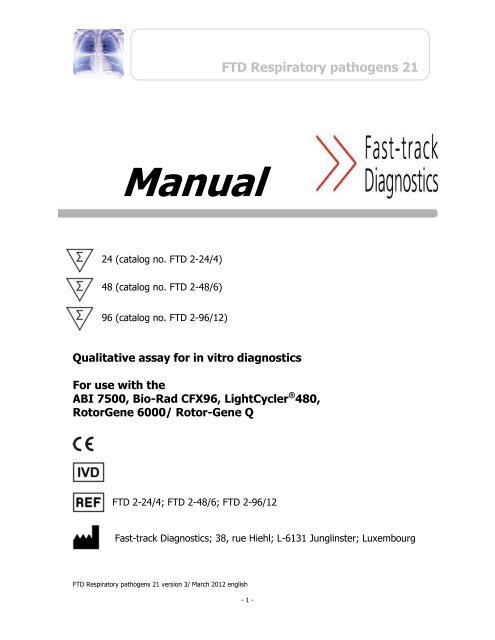
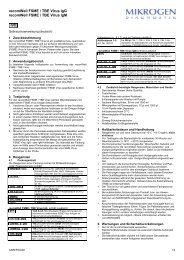

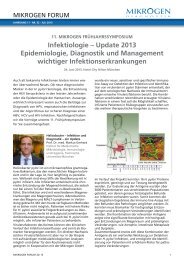

![recomLine EBV IgG [aviditet] [IgA] recomLine EBV IgM - Mikrogen](https://img.yumpu.com/19720026/1/184x260/recomline-ebv-igg-aviditet-iga-recomline-ebv-igm-mikrogen.jpg?quality=85)
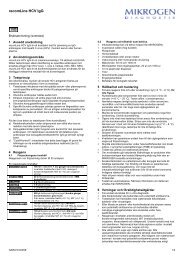
![recomBlot CMV IgG [Avidità] - Mikrogen](https://img.yumpu.com/16294013/1/184x260/recomblot-cmv-igg-avidita-mikrogen.jpg?quality=85)
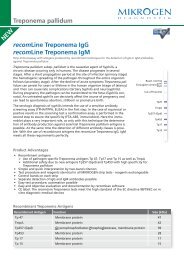
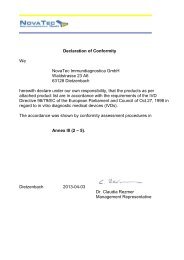
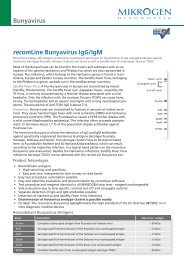
![recomBead Yersinia IgG recomBead Yersinia IgA [IgM] - Mikrogen](https://img.yumpu.com/15461030/1/184x260/recombead-yersinia-igg-recombead-yersinia-iga-igm-mikrogen.jpg?quality=85)
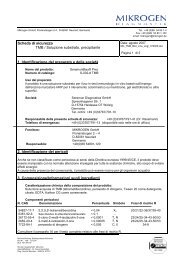
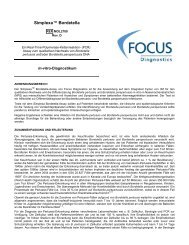
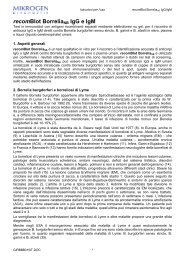
![recomLine EBV IgG [Avidity] [IgA] recomLine EBV IgM ... - Mikrogen](https://img.yumpu.com/6326010/1/184x260/recomline-ebv-igg-avidity-iga-recomline-ebv-igm-mikrogen.jpg?quality=85)